Tasty and juicy filling wrapped with pleasantly chewy skin, Chinese pork dumpling with Napa cabbage is an absolute classic! This recipe includes make-from-scratch instructions and a tutorial video.

If you’ve found my blog through my Ultimate Dumpling Guide, you know how passionate I am about this delectable Chinese delicacy. Having published multiple dumpling posts, I’ve just realised that I haven’t shared a recipe for the classic pork dumplings (Zhu Rou Shui jiao/猪肉水饺) that my parents made regularly throughout my childhood.
It’s safe to say that boiled dumplings with pork and Napa cabbage filling are the most popular variety in Northern China where dumplings are a common dinner option. I absolutely love the clean taste of this type of dumplings. With a simple dipping sauce, they make a tasty & healthy all-in-one meal.
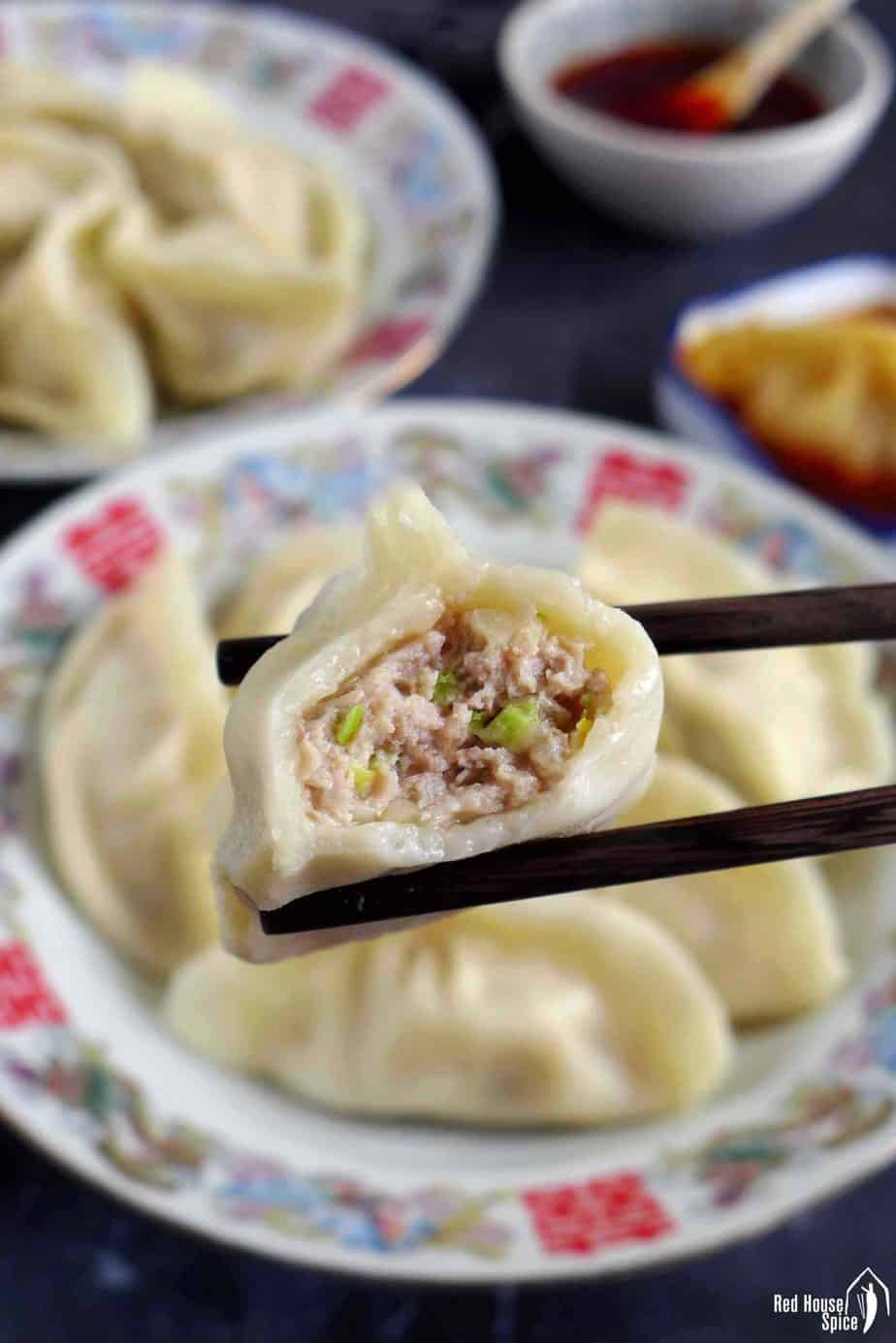
Having helped my parents to make this dish since I was a child, I know every detail of the recipe by heart. So I’ll break the entire process into easy-to-follow “bite-sized” sections to help you replicate the dish with confidence.
A tasty & juicy filling
Here is a list of ingredients that you need to make the pork and cabbage filling (Precise measurements are provided in the recipe card at the end of the post).
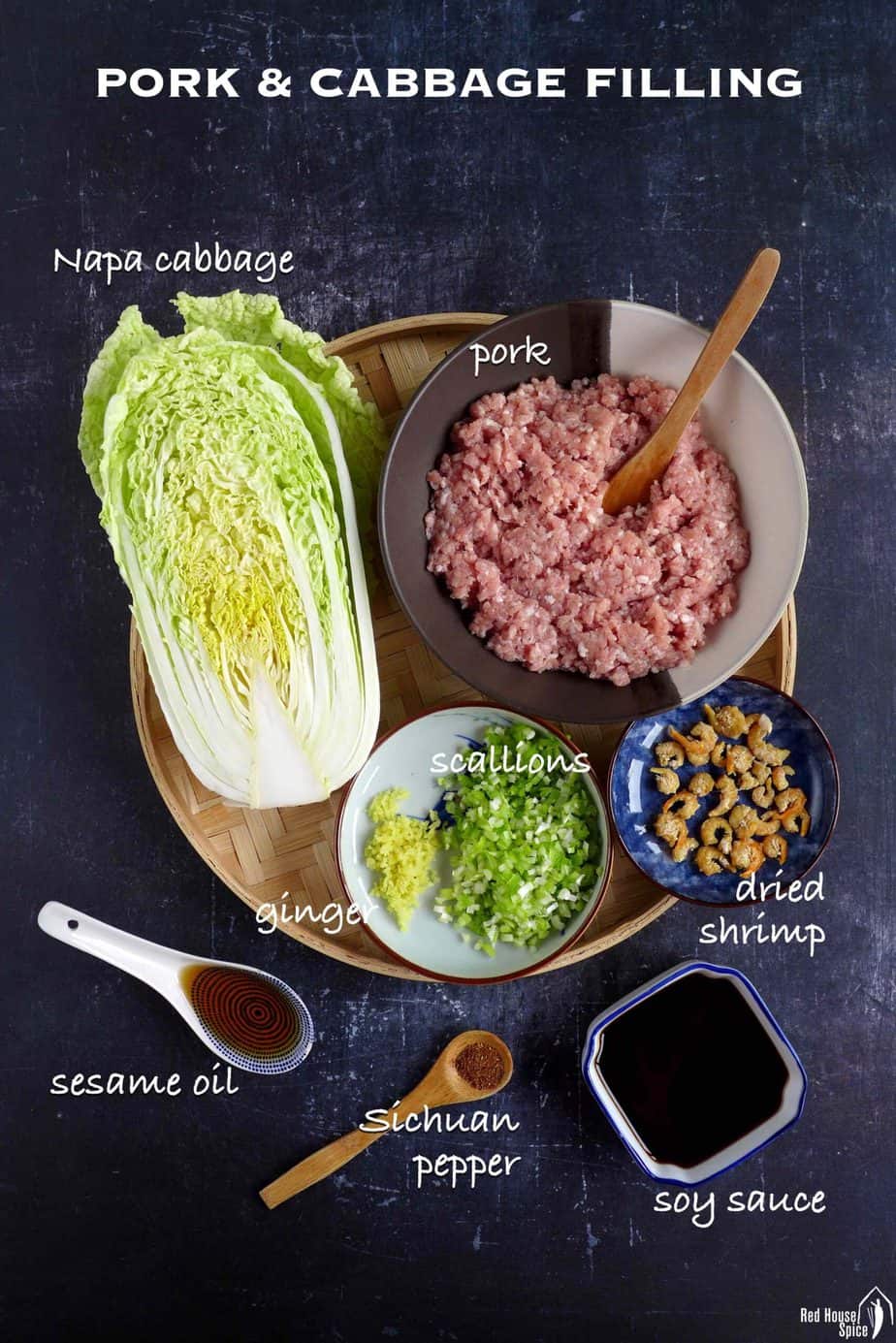
- Minced pork. For best taste, choose one with high-fat content, preferably no less than 20%.
- Napa cabbage, also known as Chinese cabbage.
- Scallions & ginger. They’re essential aromatics for meat-based dumpling fillings.
- Light soy sauce. It’s fine to use soy sauce that’s not specified as light or dark.
- Ground Sichuan pepper (or Chinese five-spice powder).
- Dried shrimp (or dried scallops). Offering complex umami flavour to the filling, it needs to be pre-soaked in water until soft then chopped into tiny pieces.
- Sesame oil. It adds a distinctive aroma and helps to lock in the moisture of the meat.
As I’ve explained in my Dumpling Filling Guide, a good filling shouldn’t taste dry, yet it can’t be overly wet as it will make assembly impossible.
🛎 Tips:
- In Chinese households, Napa cabbage is usually hand-chopped into tiny pieces. If using a food processor, remember not to overdo it. Otherwise, you’ll end up with a watery mess.
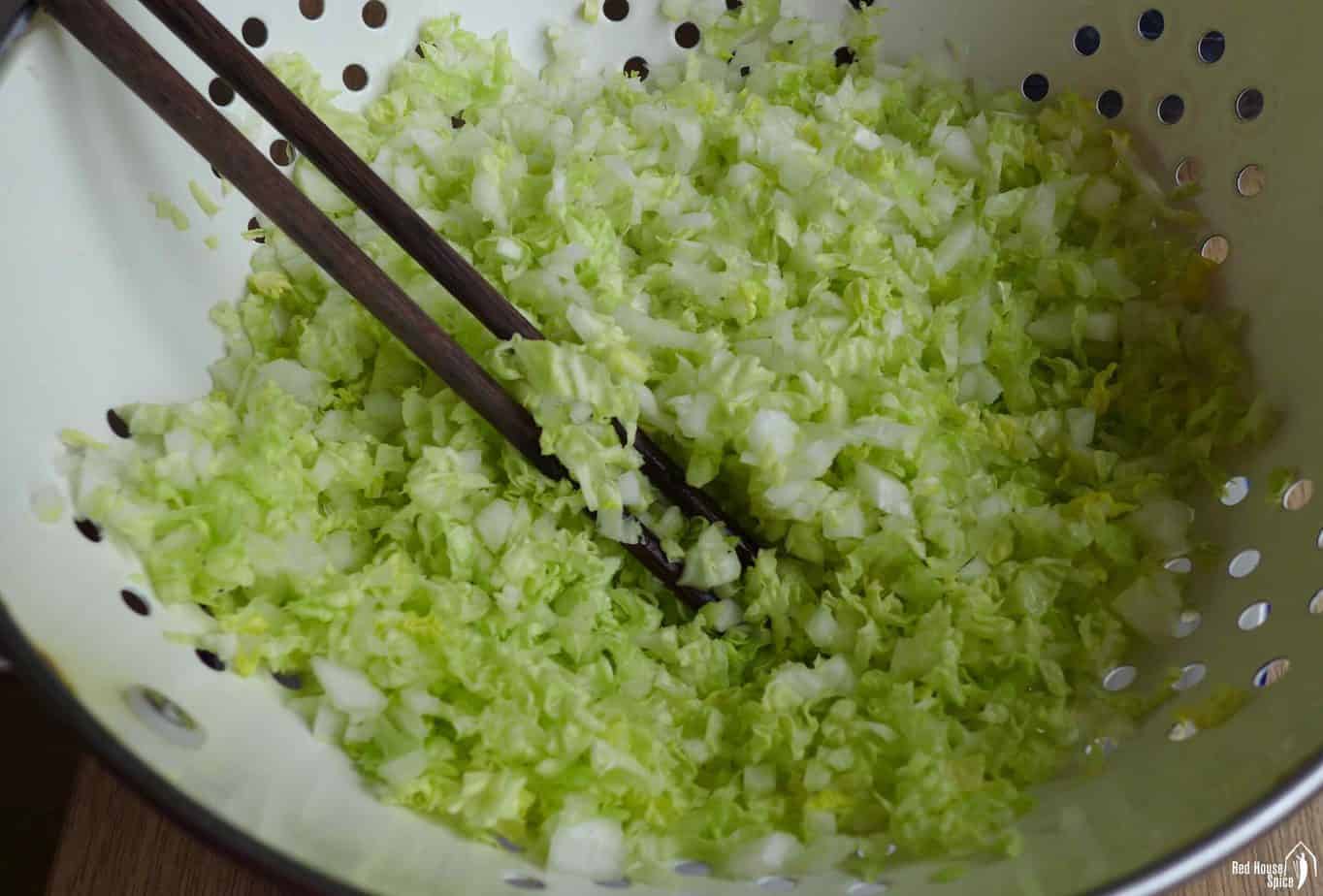
- Do not add finely chopped Napa cabbage directly into the meat. Instead, stir in some salt and leave to rest for a while.
- Mix the pork with minced scallions, ginger, light soy sauce, ground Sichuan pepper and minced dried shrimp (along with the water in which it was soaked). Stir until the liquid is fully absorbed by the meat.
- Squeeze the cabbage in batches to remove water extracted by the salt. Add to the pork. Pour in sesame oil and mix to combine.
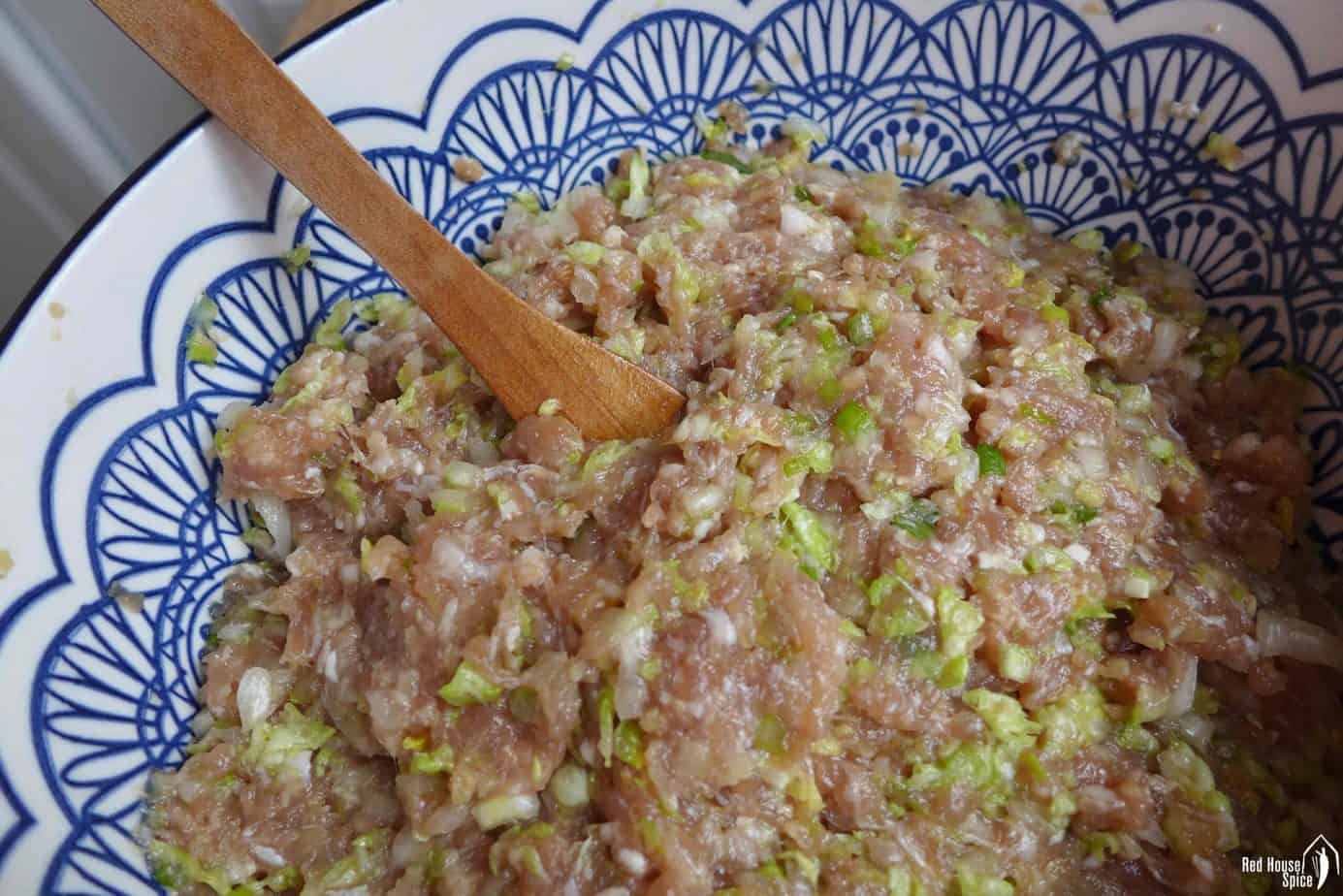
- Do not combine the pork and the cabbage until you’re ready to assemble the dumplings. If you wish to prepare the filling in advance, store the seasoned meat and squeezed cabbage separately. Mix them right before the assembly takes place.
Homemade wrappers
Have you tried making your own dumpling wrappers? Do you know it requires only all-purpose flour (plain flour) and water to make them? And they taste much better than shop-bought ones!
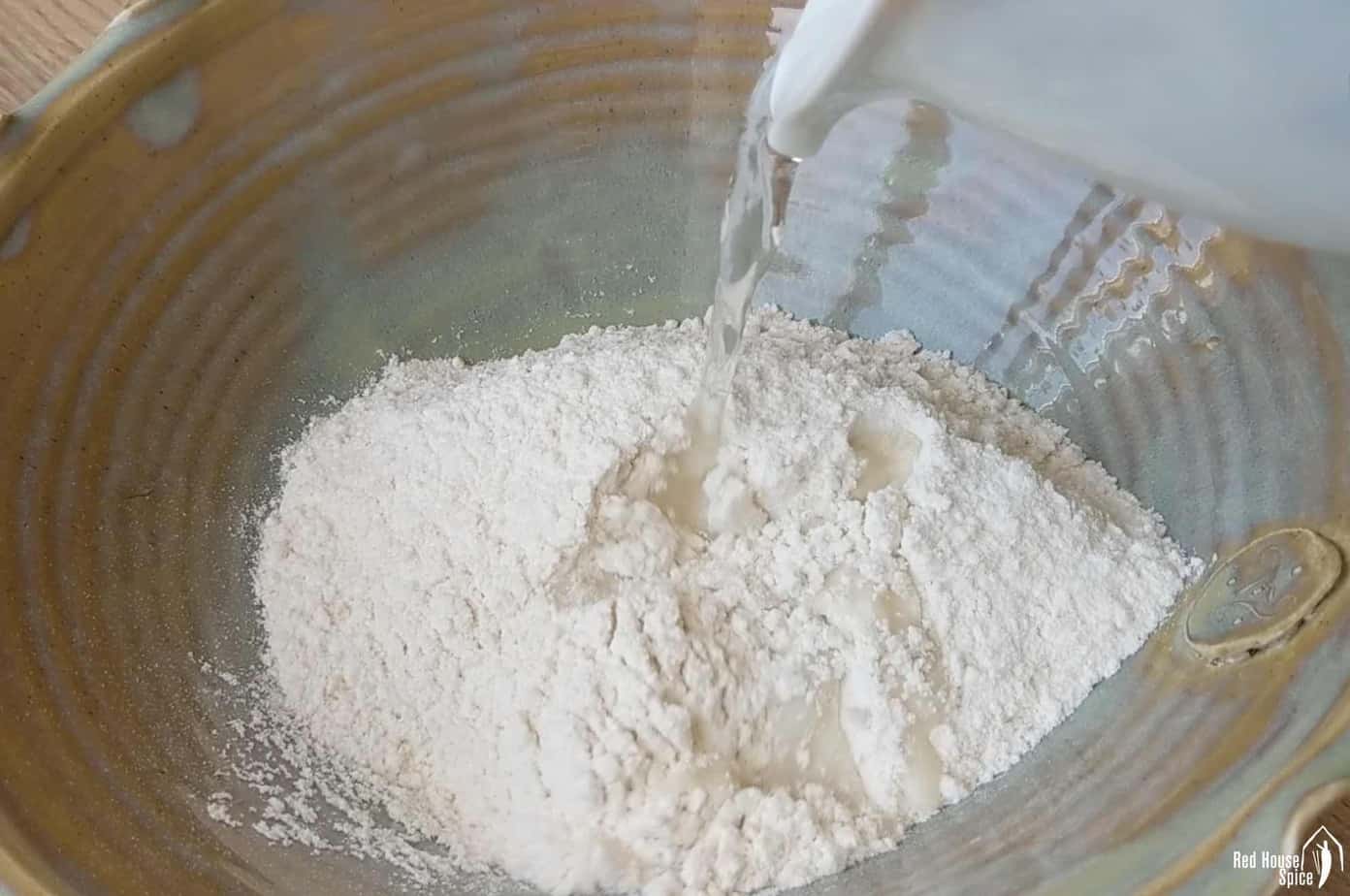
Flour-water ratio
The flour-water ratio is about 2:1 by WEIGHT (not by volume). For example, to make a dough for about 30 wrappers, you’ll need
- 250 g all-purpose flour/plain flour (about 2 cups)
- 130 g water at room temperature (½ cup+2 tsp)
🛎 Tips:
- It’s fine to use measuring cups but be aware that it’s less accurate and you’ll need to do it properly: sift the flour first then spoon it into the cup (without pressing). Scrape across the cup with the back of a knife to level.
- Depending on the brand of your flour and the humidity of your kitchen, you may need to adjust the water slightly. The initial dough should be medium-firm and it will become softer after resting (watch the tutorial video in the recipe card below to see the desired consistency).
Knead & rest
Making the dough is pretty straightforward. Combine flour and water then knead it into a smooth dough. You may achieve this either by hand or using a stand mixer with a dough hook.
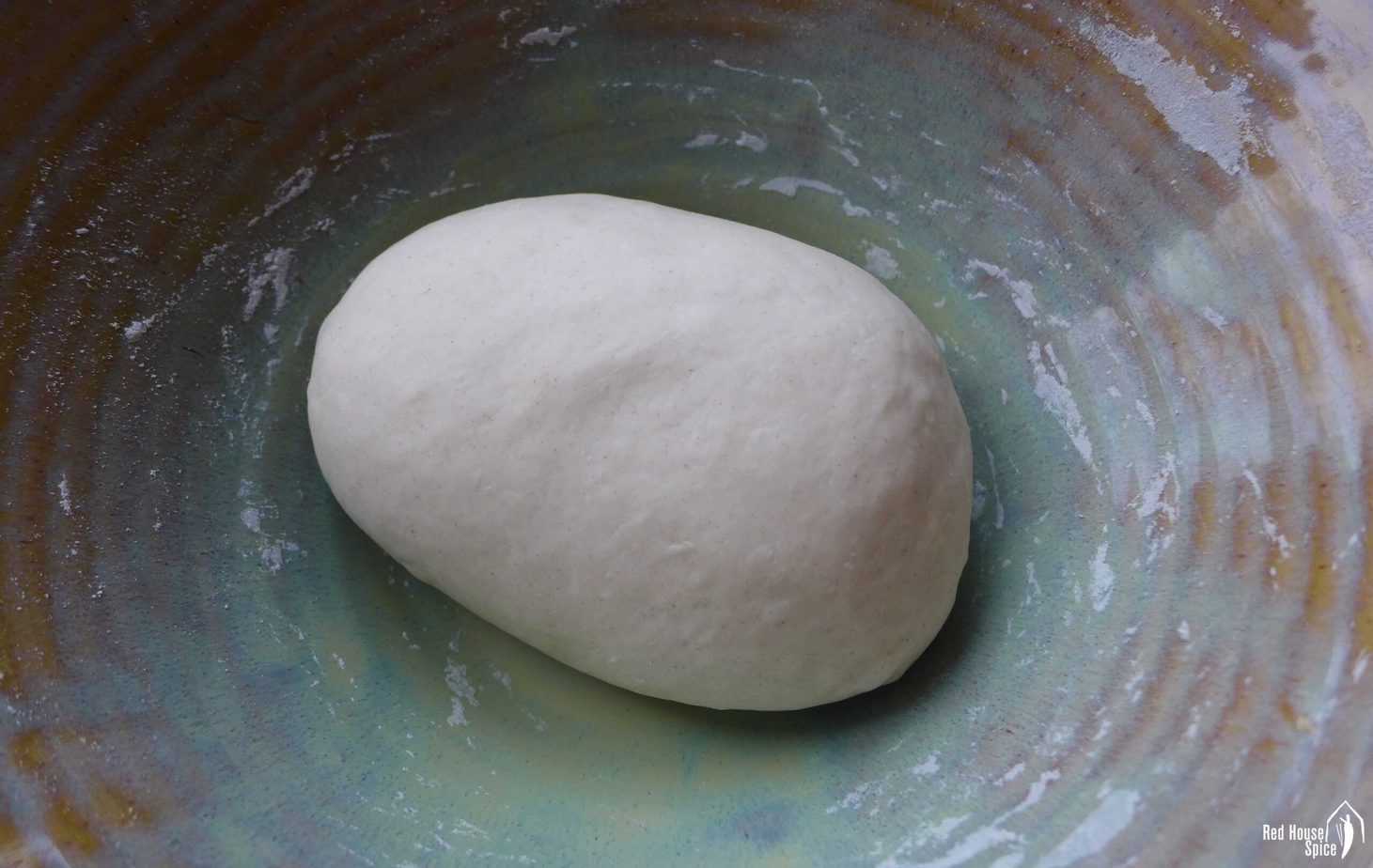
- By hand: After forming a rough-looking dough, leave it to rest for 10 minutes then knead it again. This way it’ll take you very little effort to achieve the smoothness.
- With a stand mixer: Mix and knead the dough on low speed for about 8 minutes.
Once the dough is done, cover it and leave to rest for at least 30 minutes. It’ll become softer, more stretchy thus ready to be rolled out into wrappers.
Roll the wrappers
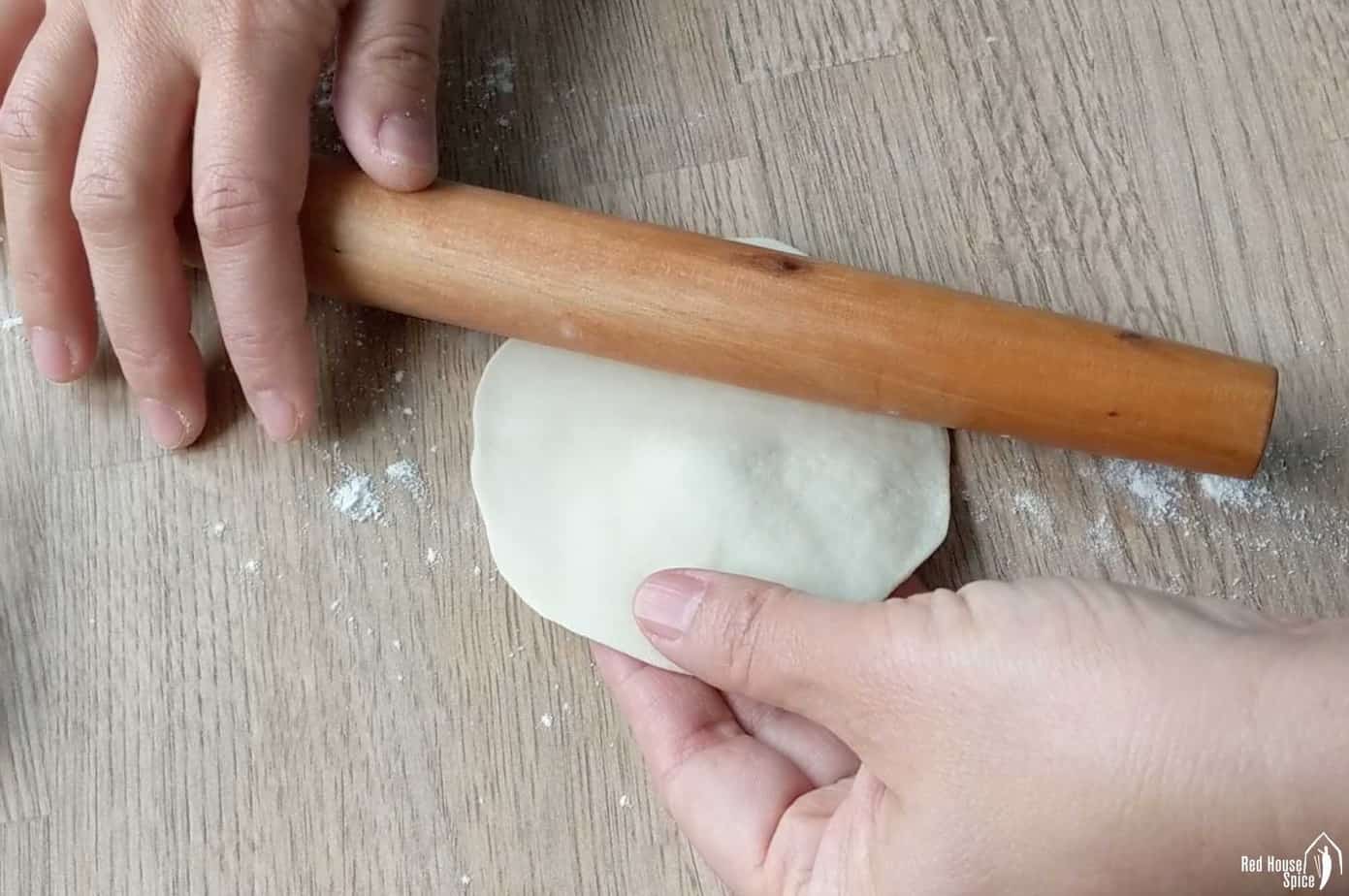
- Roll the dough into a loop (or a few ropes). Then cut it into equal, small pieces.
- With the palm of your hand, flatten each piece into a round disc.
- Use a rolling pin to roll them one by one into thin wrappers.
I use the traditional “roll and turn” method to do it efficiently (The video in the recipe card below demonstrates how). Also, wrappers rolled out this way are thinner on the edge and thicker in the middle.
🛎 Tips:
- Always cover the unused dough to avoid drying out.
- Dust a little flour on the work surface and over the rolling pin to prevent sticking (but don’t overdo it).
- Try not to roll too many wrappers at once (unless someone is helping with assembly) as they dry out quickly.
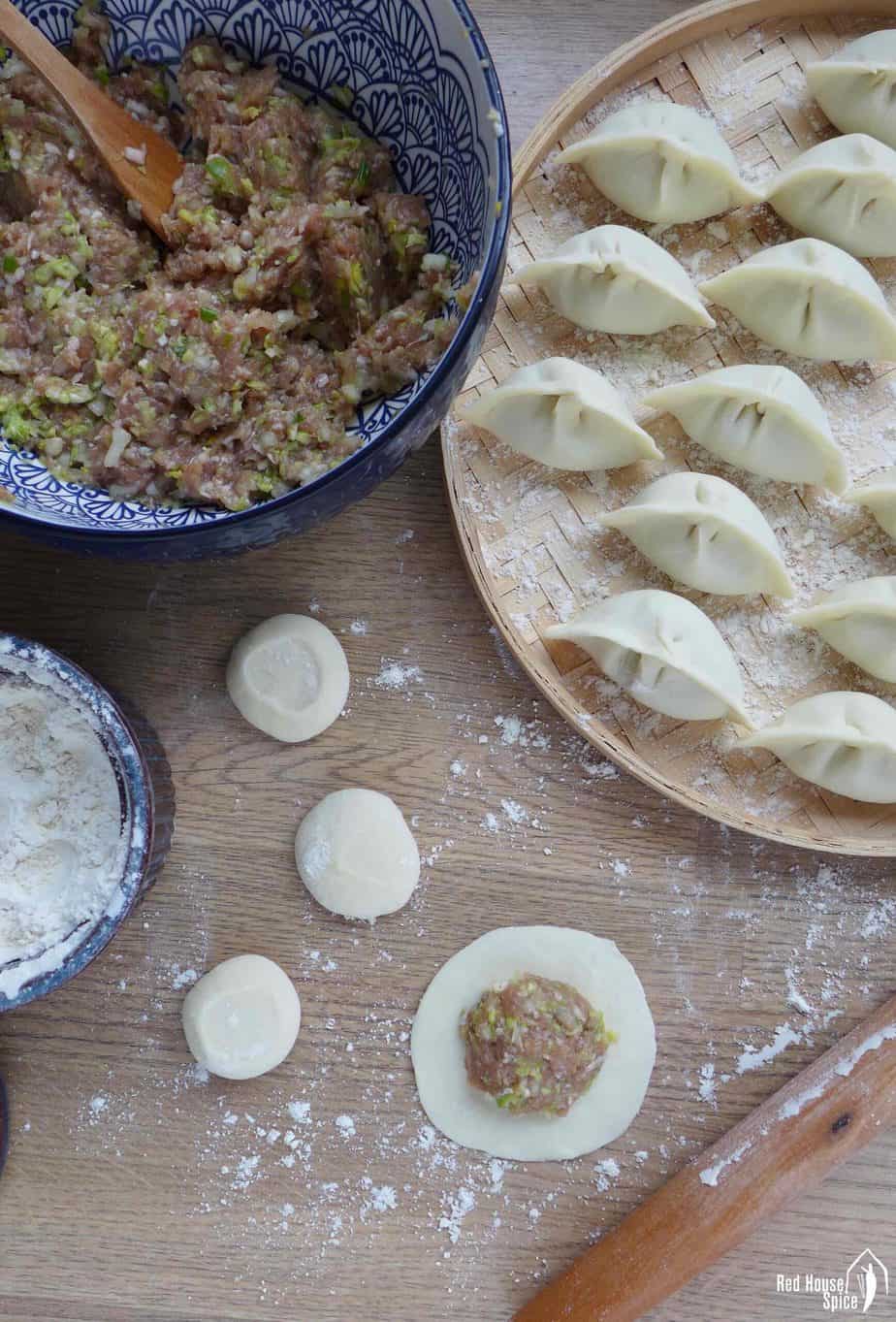
Assemble the dumplings
I’ve introduced many folding techniques in previous dumpling posts (Ten Ways to Fold Dumplings being the most comprehensive one). Yet this time, another simple variety came to my mind.
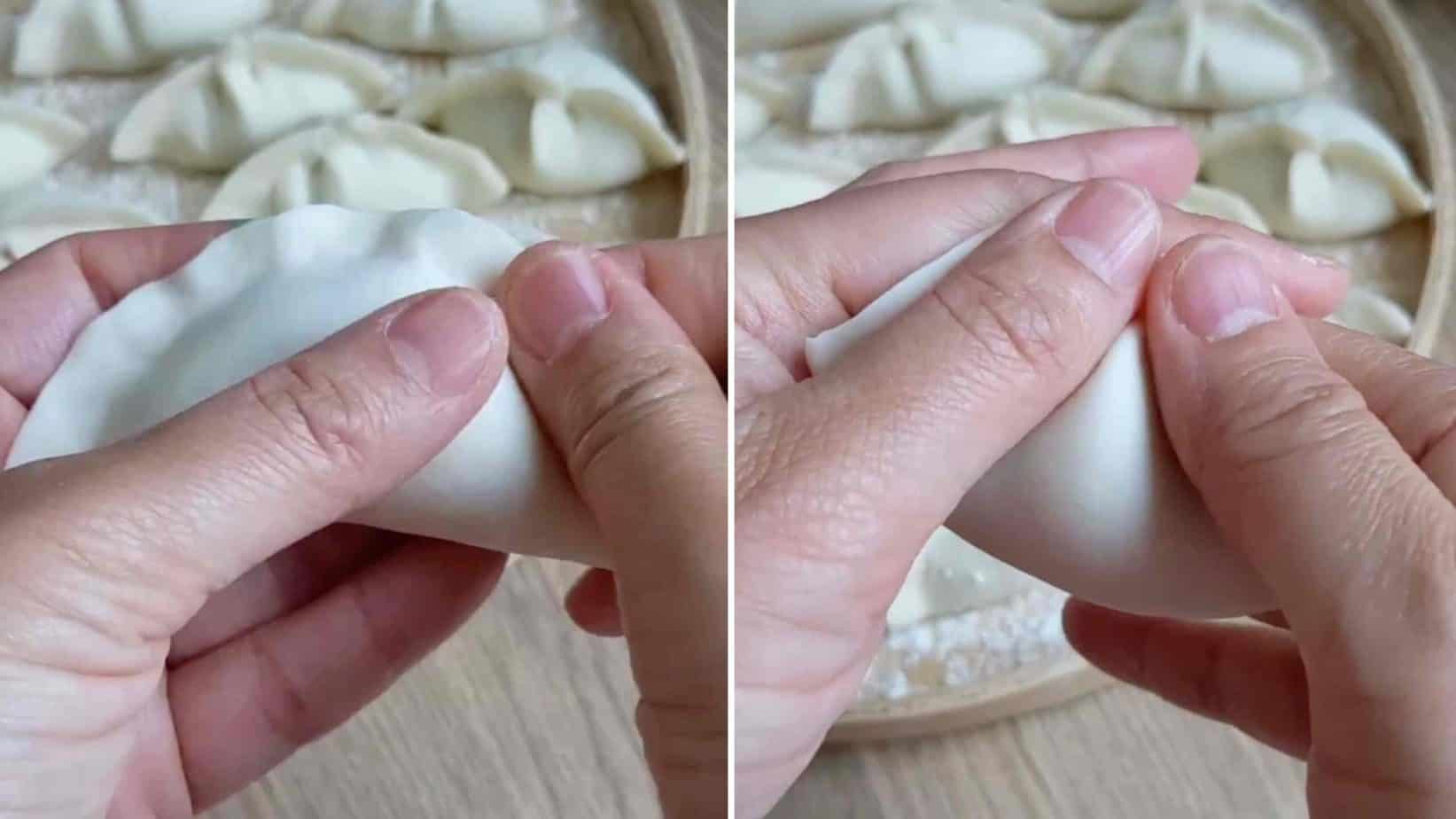
- Place a spoonful of filling in the middle of the wrapper.
- Fold the wrapper then pinch to seal all around the edge.
- Hold the dumpling in between your two thumbs and two index fingers then squeeze to shape it further (please refer to the video below).
This pattern may not look as fancy as the ones I introduced before. But if you had a chance to eat dumplings with a regular northern Chinese family, highly likely you’d see them in this form.
🛎 Tips: No matter how you pleat the dumplings, follow three rules for an optimal result:
- Make sure your seal them very well. Otherwise, the filling might leak during boiling.
- Try to wrap an appropriate amount of filling, neither too much nor too little, and avoid having too much air trapped inside the wrapper.
- Sprinkle flour over the surface where you’re placing the dumplings to prevent sticking. Don’t leave uncooked dumplings for too long before cooking (see freezing tips in later sections).
Boiling dumplings: the traditional trick
Unlike other recipes, I won’t tell you how long it takes to boil dumplings. Instead, follow the traditional trick of “Dian Shui/点水” (meaning adding water) to cook them without counting the time. Here is how:
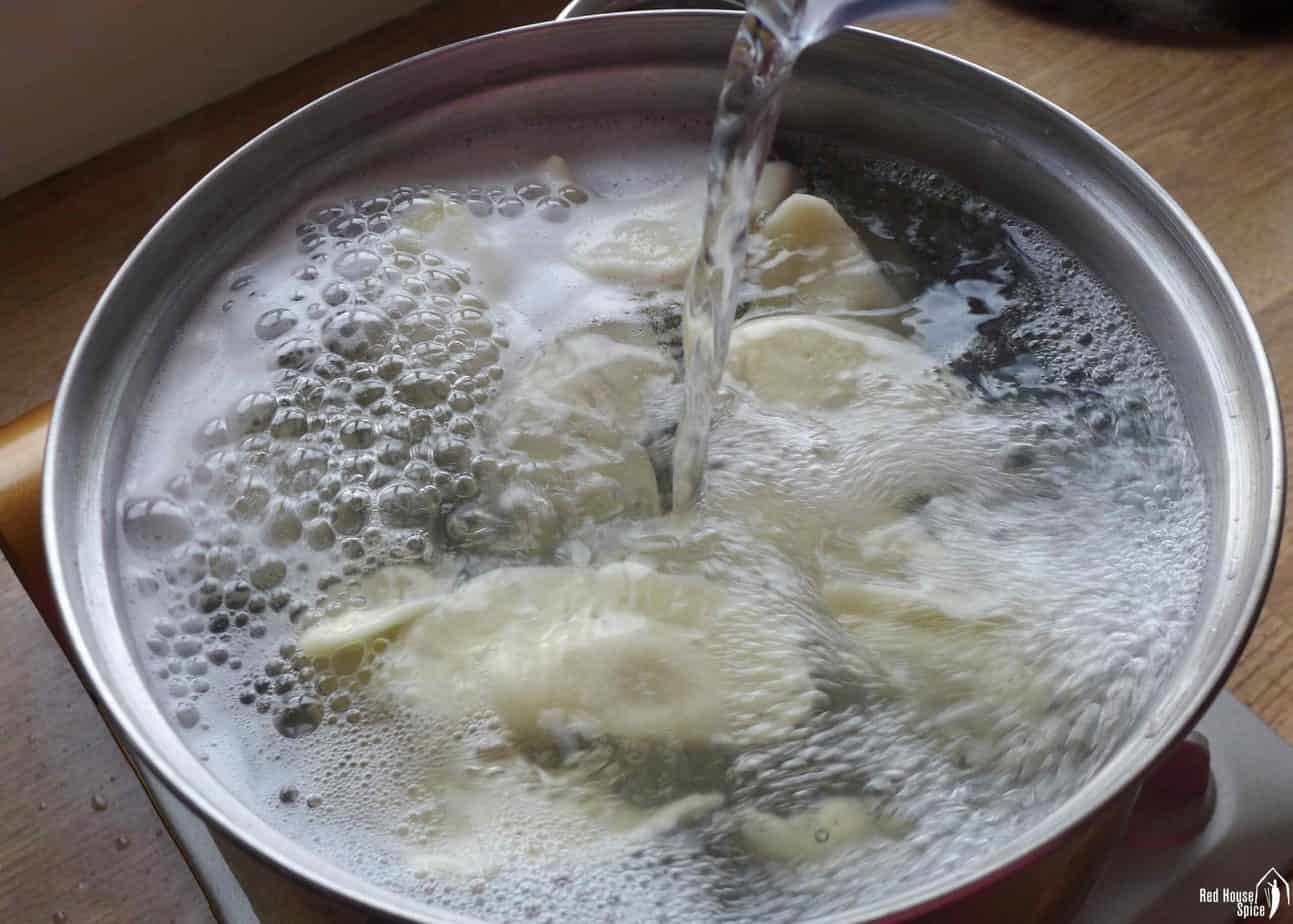
- Bring a large pot of water to a full boil then carefully slide in the dumplings (Depending on the size of your cookware, you may need to cook them in batches).
- Once the water comes back to a full boil, add some cold water to calm it down then cover with a lid. Repeat the same procedure another two time. Then your dumplings will be fully cooked.
- To remove excess starch and minimize the possibility of sticking, drain the dumplings then rinse briefly under tap water (only if it’s drinkable).
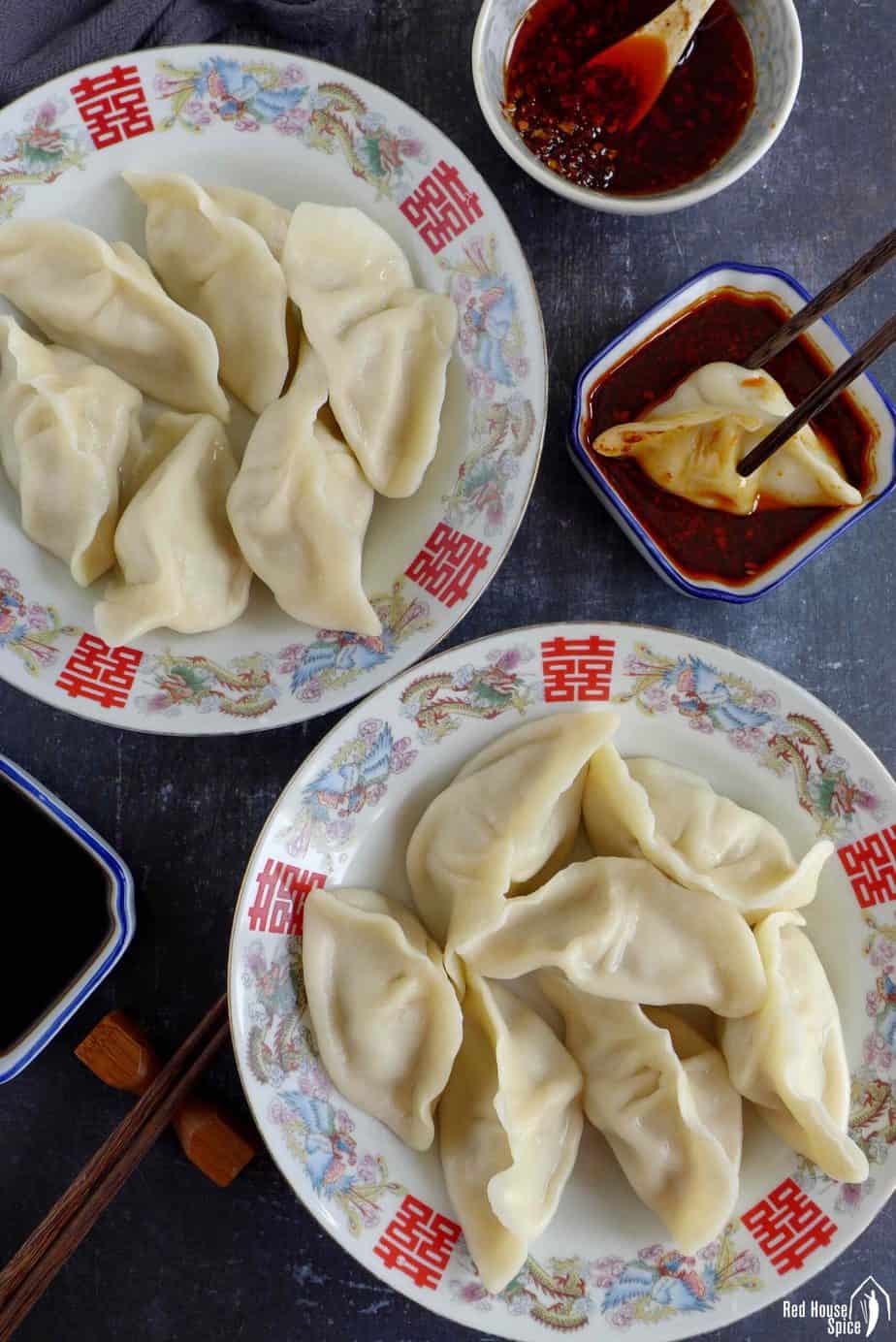
I guess you might want to ask: why add cold water three times? Well, it helps to avoid vigorous boiling. The wrappers and filling can be cooked evenly this way. Also, the wrappers have less chance of tearing or being overcooked therefore achieving a pleasantly chewy texture.
🛎 Tip: If you don’t fancy boiling, you may either pan-fry or steam them following instructions explained in my post Three Ways to Cook Dumplings.
Serve with a sauce
Don’t forget to prepare some dipping sauce for your boiled pork dumplings. Our family’s go-to quick solution is a simple mixture of Chinese black rice vinegar and homemade chili oil. Pungent and aromatic, it’ll take your dumpling meal to the next level.
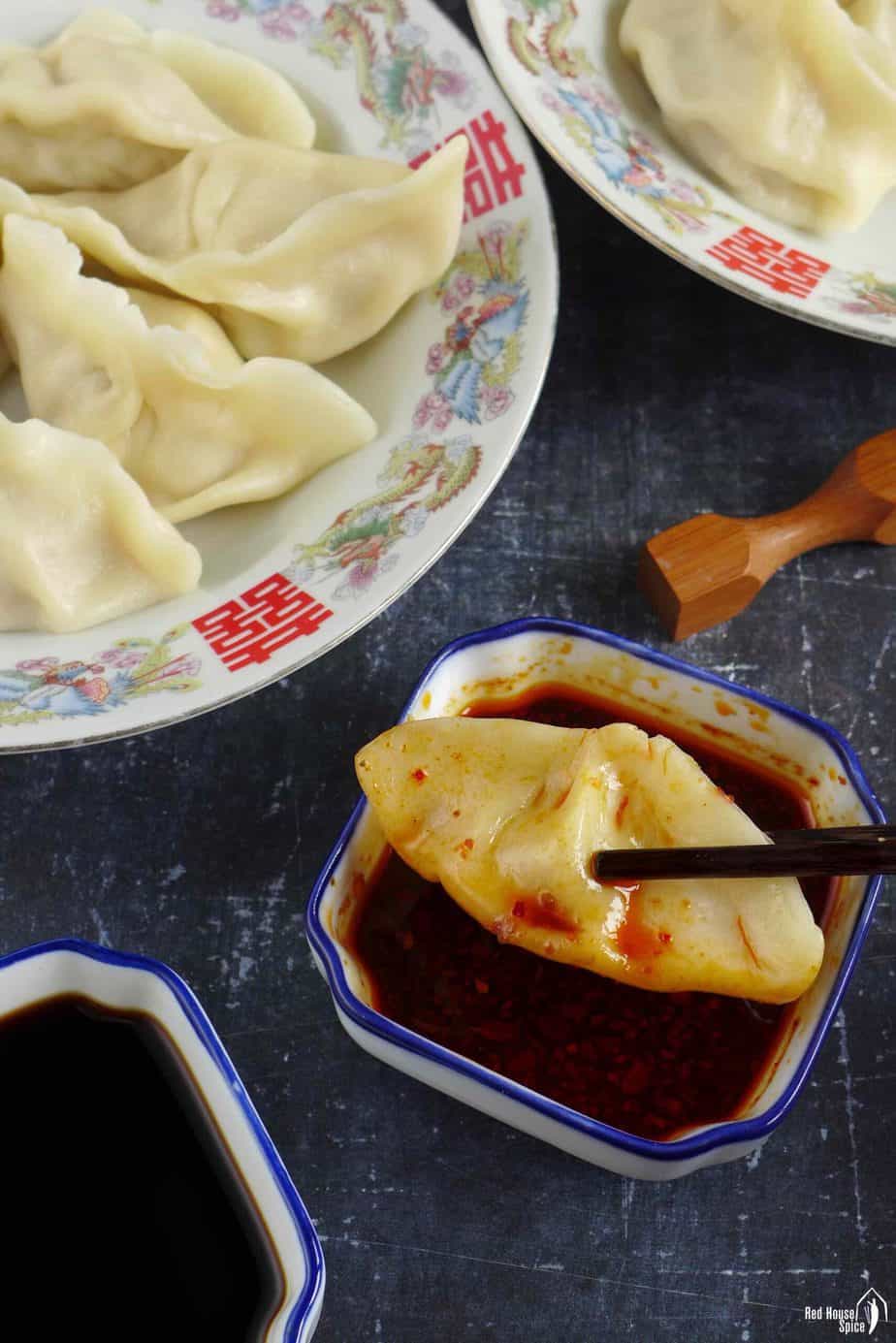
You can find more sauce ideas in my post Six Dumpling Sauces which includes non-spicy versions and a dumpling soup seasoning recipe.
Make in advance
Want to make dumplings in advance and serve later? It’s totally doable!
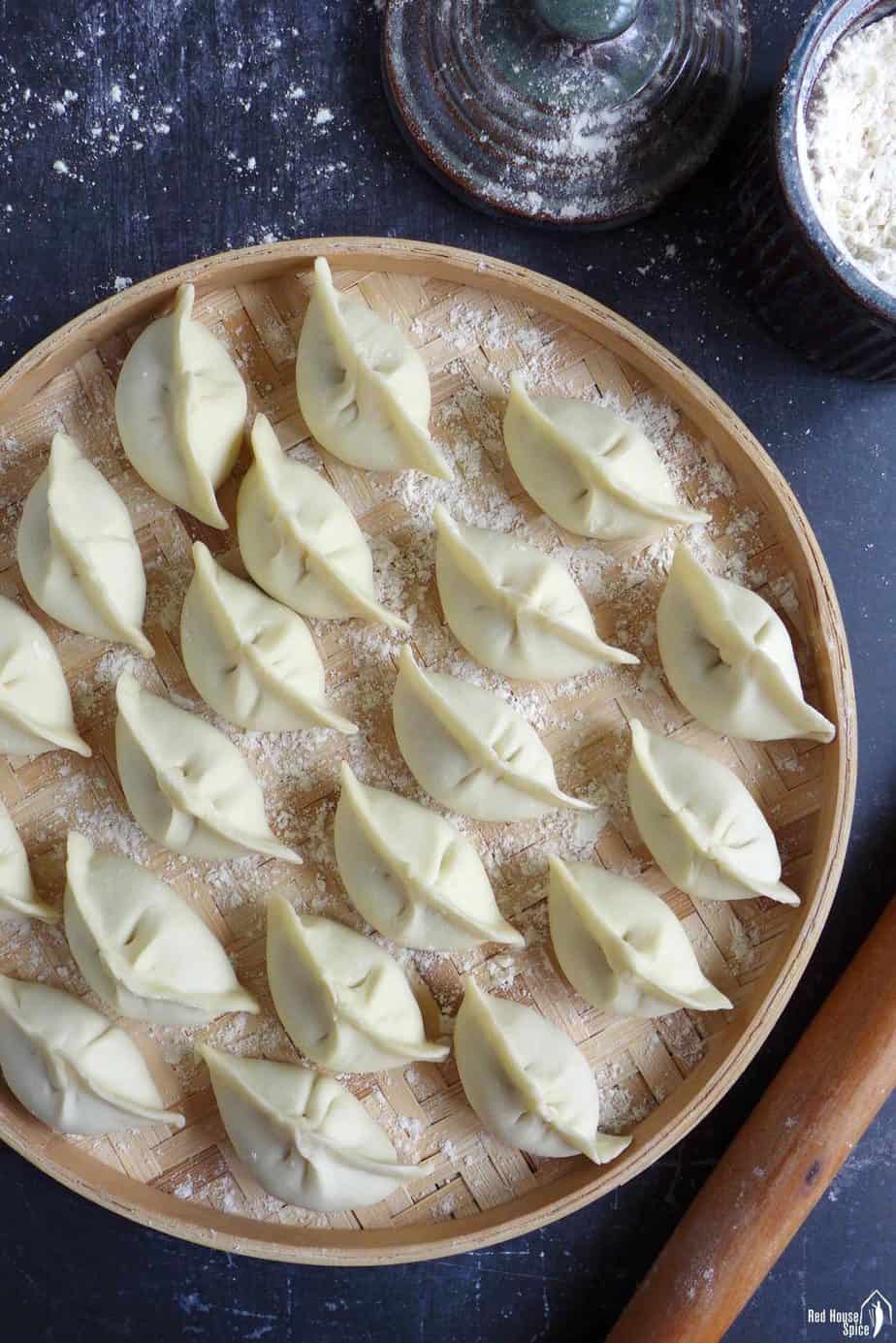
Right after they’re assembled, lay on a tray in a single layer (dusted with flour or lined with parchment paper) then freeze. Once completely frozen, transfer them into airtight bags/containers. Store in the freezer for up to three months.
Follow the same boiling method to cook frozen dumplings (Don’t defrost!).
If you have any leftover cooked dumplings, store them in an airtight bag/container in the fridge for up to 2 days. Fry them in a little oil to reheat.
More dumpling recipes
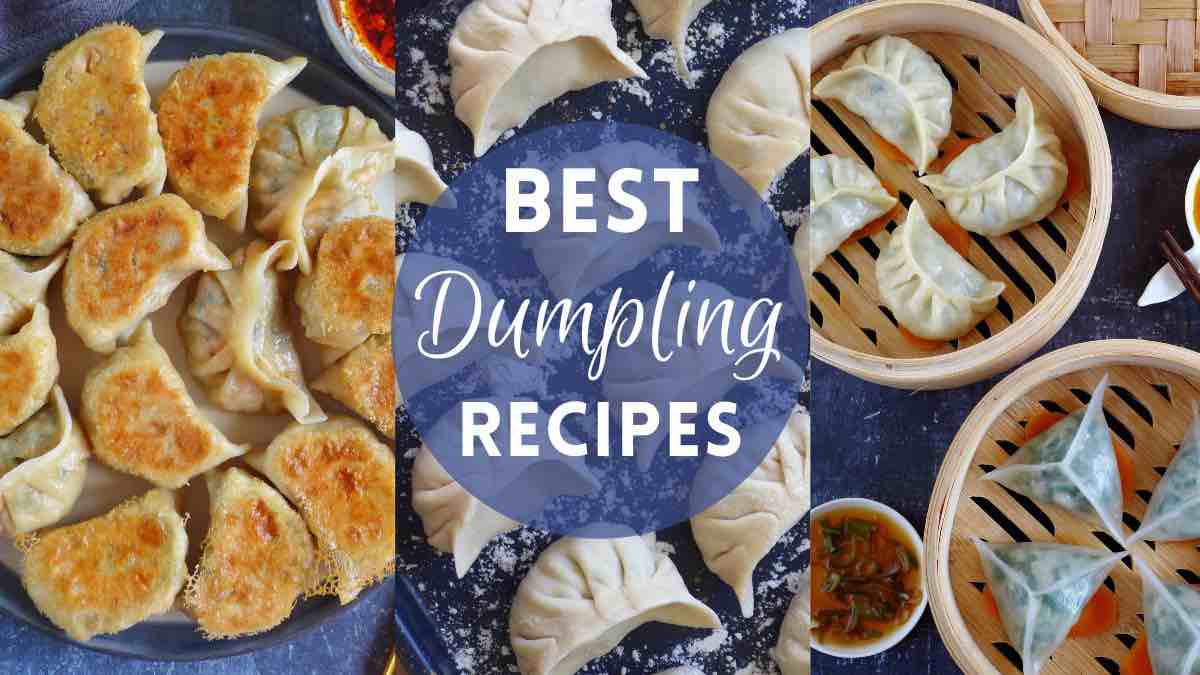
Looking for more tasty dumpling recipes?. Here are a few examples:
- Soup Dumplings (Xiao Long Bao)
- Chicken Potstickers with a Crispy Skirt
- Hot & Sour Beef Dumpling Soup
- Vegan Tofu Dumplings
- Dim Sum Shrimp Dumplings (Har How)
It has warmed my heart writing this family recipe and photographing these dumplings served in these “double-happiness/囍” plates which we have used since my childhood. Hope you enjoy this post too.
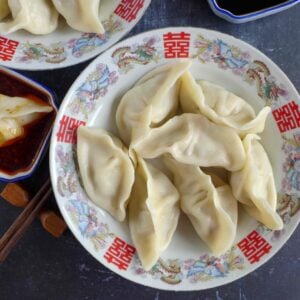
Pork Dumpling with Napa Cabbage (猪肉白菜水饺)
Ingredients
For the wrappers
- 250 g all-purpose flour/plain flour - about 2 cups (see note 1)
- 130 g water at room temperature - ½ cup+2 teaspoon (see note 2)
For the filling
- ½ head Napa cabbage (aka Chinese cabbage) - about 300g
- ¼ teaspoon salt
- 250 g minced pork - about 9oz
- 2 stalk scallions - finely chopped
- 1 teaspoon minced ginger
- 2 tablespoon light soy sauce
- 1 pinch ground Sichuan pepper - or five-spice powder
- 1 tablespoon dried shrimp - soaked in 2 tablespoon water until soft (see note 3)
- ½ tablespoon sesame oil
For serving
Instructions
Make the dough
- In a mixing bowl, add water to flour gradually. Mix with chopsticks/spatula until no more loose flour can be seen. Combine and knead into a dough.
- Leave to rest (covered) for 10 minutes then knead again until smooth.
- Cover and rest the dough again for 30-60 minutes until it becomes soft (Chinese cooks would say “as soft as an earlobe”).
- If using a machine: Add flour and water into the mixing bowl. Knead on low speed for 8 minutes or so until smooth. Cover and rest for 30-60 minutes.
Mix the filling
- Cut Napa cabbage into thin slices then cut across again into tiny pieces. Put minced cabbage into a colander then add salt. Mix well and leave to rest for 10 mins or so (place the colander in a sink or over a plate to collect extracted water).
- Add minced pork, scallions, ginger, light soy sauce and ground Sichuan pepper to a mixing bowl. Mince rehydrated dried shrimp. Add it to the meat, along with the water in which it was soaked. Stir until the liquid is fully absorbed by the meat.
- Use your hands to squeeze the cabbage in batches to remove any water extracted by the salt. Then put into the bowl. Add sesame oil and mix to combine.
Roll the wrappers
- Divide the dough into three parts. Roll one part into a rope then cut into 10 equal sections (cover the rest to avoid drying out).
- Press each piece into a small disc with the palm of your hand. Use a rolling pin to flatten it into a thin disc (Please refer to the tutorial video below). Dust with flour if it sticks. Repeat to finished the rest of the dough.
Assemble the dumplings
- Place a spoonful of filling on the wrapper. Seal the wrapper using the technique you're most comfortable with. Please refer to the tutorial video below or the methods demonstrated in "Ten Ways to Fold Dumplings".
Boil the dumplings
- Bring a pot of water to a full boil over high heat. Gently slide in the dumplings (cook in two batches if using a small pot). Push them around with the back of a spoon to avoid sticking. Cover with a lid.
- When the water comes back to a full boil, add about 120 ml (½ cup) of cold water then cover.
- Repeat the procedure another two times. When fully cooked, the dumplings should be plump and floating on the surface.
- Transfer the dumplings to a colander. Briefly rinse under tap water (make sure it’s drinkable water). Drain and serve immediately.
Serve the dumplings
- Serve the dumplings warm with a mixture of homemade chili oil and black rice vinegar. Or read Six Dumpling Sauces for more inspirations.
Freeze uncooked dumplings
- Place assembled, uncooked dumplings on a tray lined with parchment paper (or dusted with flour). Put into the freezer.
- Once completely frozen, transfer them into an airtight plastic bag/container. Use within three months.
Cook frozen dumplings
- No need to defrost before cooking. Follow the boiling instructions explained above.
Video
NOTES
NUTRITION
NUTRITION DISCLOSURE: Nutritional information on this website is provided as a courtesy to readers. It should be considered estimates. Please use your own brand nutritional values or your preferred nutrition calculator to double check against our estimates.


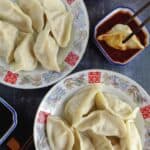
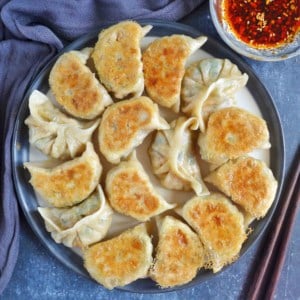
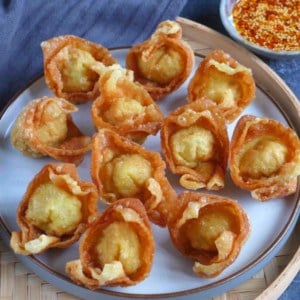
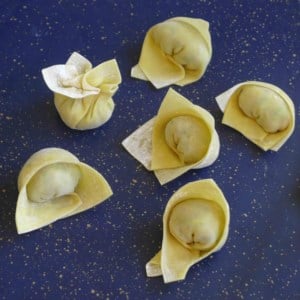
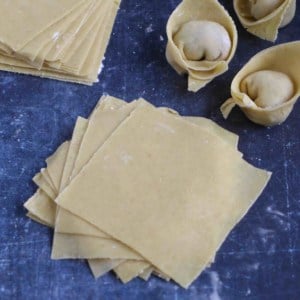
Hi Wei, thankyou so much for your recipes. Have tried many of them and have found them relatively easy and all of them oh so good. Have even got my folding perfected thanks to your dumpling folding video. We seem to be living on yum cha of late – no complaints. Dan dan noodles, sublime. Oh, we love it all. Thanks again.
S xx
Living on Yum Cha is the dream! So happy to know you enjoy cooking my recipes.
Looks amazing. Over the years I have been making slightly different versions of this meal.I just love Chinese dumplings. Especially where I am based in the North of Manchester UK, most of the year it’s always cold and raining, and grey.. Chinese dumplings helps to keep the grey clouds away. 😋
Yes, dumplings are so comforting on cold days. That’s why they are particularly popular in the northern part of China, where it’s cold for half of the year.
Can I make the dumpling filling ahead of time and freeze it? I am trying to have a dumpling making party but won’t have a ton of time leading up to the party!
Yes, you can freeze the filling before hand, or store it in the fridge for a day. Happy cooking!
Even though I don’t respond to all yr recipes, I must say they are so good and easy to follow, delicious to eat n inspiring. Thanks for your efforts n thoughts, thank you 🙏 keep them coming, I always want to learn from you.
You’re welcome Janet! Wish you a fun time in the kitchen.
Exactly how I make them, except for the dried shrimp. I will have to try that next time. keep “em” coming
Cheers,
Charlie
Well done!Dumplings are my all-time favourite. Looking forward to making this recipe as an evening snack. I have made it several times, but this one is quite different. But I would love to combine this recipe with ghee oil for that extra nuttiness. Clarified butter smoke point is higher than sesame oil and a safer bet for cooking. You can also drizzle ghee before serving to enhance the flavor.
Thank you for sharing your twists.
I would appreciate your giving a weight for the nappa cabbage as they come in so many sizes.
It’s about 300g. I’ve added this measurement in the recipe card. Happy cooking!
Hey.
There don’t seem to be any dried shrimp or dried scallops for sale in Finland, so could they be replaced with umami spice? Thanks in advance.
I’ve just Googled what umami spice is. I think it’s a good idea to use it as a substitute. Happy cooking!
I’ve made these twice now – once with Napa cabbage and once with baby bok choy – both times very delicious! And so easy! A experienced cook suggested instead of dried shrimp, to add minced shiitake mushrooms to achieve that unami flavor and it worked great! He suggested adding 1 teaspoon of fish sauce in addition to the hot water when rehydrating the mushrooms. Then adding some of the fish sauce/mushroom water to the pork mixture. Sure it might not be traditional but they taste great! Flavors reminded me of great dim sum dumplings in Richmond, BC, Canada.
Thank you Don for sharing your ideas. My readers will appreciate your input for sure!